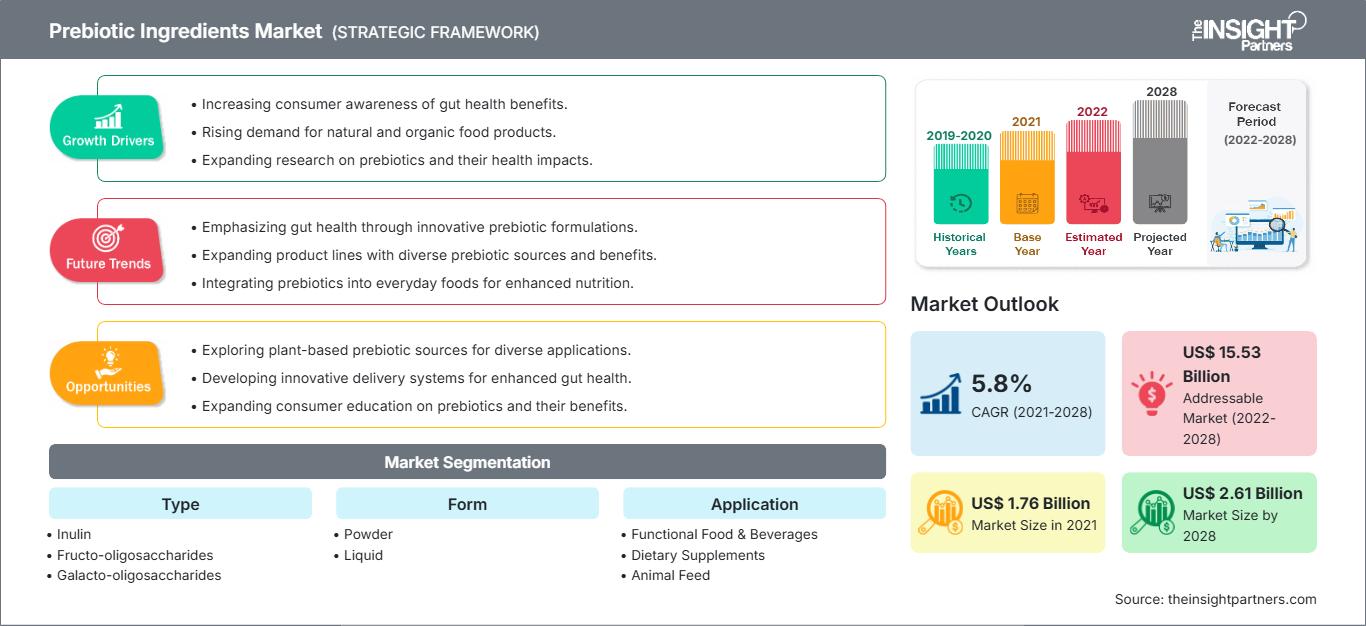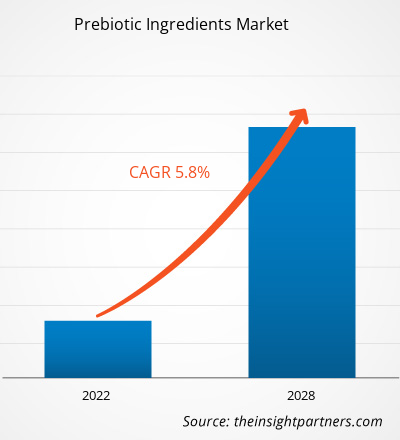[研究报告]益生元成分市场预计将从2021年的17.584亿美元增长到2028年的26.0772亿美元;预计2022年至2028年的复合年增长率为5.8%。
益生元是食物中能够诱导细菌和真菌等有益微生物生长或活性的化合物。发酵是有益细菌在结肠中利用益生元的主要作用机制。益生元在预防性医疗保健中发挥着重要作用,因为富含纤维的营养补充剂在运动爱好者和运动员中越来越受欢迎,以增强他们的体力和耐力,这进一步刺激了对益生元成分的需求。因此,预防保健意识的不断增强正在推动益生元成分市场的增长。
2021年,亚太地区占据了最大的益生元成分市场份额,而中东和非洲等其他发展中地区预计在预测期内也将大幅增长。市场增长归因于肠道健康和免疫健康障碍的增加,以及消化系统疾病的增多。亚洲国家倾向于采用健康营养的食品和饮料来改善肠道健康。因此,对健康食品的偏好正在推动益生元成分市场的增长。
自定义此报告以满足您的要求
您将免费获得任何报告的定制,包括本报告的部分内容,或国家级分析、Excel 数据包,以及为初创企业和大学提供超值优惠和折扣
益生元成分市场: 战略洞察

-
获取本报告的主要市场趋势。这个免费样本将包括数据分析,从市场趋势到估计和预测。
COVID-19 疫情对益生元成分市场的影响
2020 年初,COVID-19 疫情给许多行业带来了前所未有的挑战。各国政府根据世界卫生组织和各国卫生部的指导方针采取的封锁、边境限制、旅行禁令、生产停工和其他安全措施阻碍了制造业的运营。然而,COVID-19 疫情也对市场产生了积极影响,因为越来越多的消费者开始寻求天然、更安全的替代品来保持健康并增强免疫系统。在 COVID-19 疫情爆发的最初几个月,对膳食补充剂的需求急剧增加。此外,由于政府强制要求人们待在家里,他们更加注重健康和健身,这刺激了 COVID-19 疫情期间对益生元的需求。
市场洞察
食品和饮料中对益生元成分的需求不断增长
饮料行业益生元在食品饮料行业越来越受欢迎,因为它们广泛应用于营养棒、乳制品、健康饮品、矿物质补充剂、早餐麦片、烘焙食品、糖果、绿色食品和婴儿配方奶粉。2018 年 11 月,家乐氏公司以 HI! Happy Inside 为品牌推出了一款新型麦片,其中包含益生元和益生菌,作为其肠道促进消化产品系列的一部分。此外,菊粉被广泛应用于食品加工,因为它是脂肪和糖的良好健康替代品。美国、印度和中国等主要牛奶生产国利用益生元为最终产品提供所需的质地,并生产无糖乳制品。此外,婴儿配方奶粉或婴儿食品含有各种益生元成分,包括低聚半乳糖、低聚果糖和聚葡萄糖。这些是推动益生元成分市场增长的因素。
基于类型的洞察
根据类型,益生元成分市场细分为菊粉、低聚果糖 (FOS)、低聚半乳糖 (GOS)、低聚甘露糖 (MOS) 等。预计菊粉将在预测期内占据最大份额。制造商将其用于加工食品和饮料、膳食补充剂和动物饲料中,以替代糖、脂肪和面粉。2018 年,美国食品药品监督管理局 (FDA) 批准菊粉作为膳食纤维成分,以提高制成食品的营养价值。此外,对天然产品的持续增长需求也增加了全球对益生元菊粉的需求。菊粉细分市场的增长得益于其在各行各业日益广泛的应用,从而推动了益生元成分市场的增长。
基于形态的洞察
根据形态,益生元成分市场分为粉末和液体。预计在预测期内,粉末细分市场的复合年增长率将更高。粉末形态使益生元的分销和利用更加便捷。由于粉末益生元可在牲畜的任何生命阶段食用,因此在畜牧生产中使用益生元粉末的益处日益凸显。此外,肉类、蛋类和牛奶产量的提高也增加了对粉末益生元的需求。
基于应用的洞察
根据应用,益生元成分市场分为功能性食品和饮料、膳食补充剂、动物饲料等。预计在预测期内,膳食补充剂细分市场的复合年增长率最高。预防性药物需求的不断增长、老年人消化系统疾病的增多以及饮食不均衡,都可能增加膳食补充剂行业的产品需求。由于不健康饮食的日益盛行,消费者越来越青睐益生元类食品补充剂。
益生元成分市场的主要参与者包括 BENEO GmbH、COSUCRA、杜邦营养与生物科学公司、Clasado Ltd.、Nexira、Ingredion Incorporated、SOLACTIS、嘉吉公司、Sensus 和 Roquette Frères。这些参与者致力于开发低健康风险的产品,以满足新兴的消费趋势并遵守监管框架。他们通过并购、业务扩张和合作来扩大市场份额。
益生元成分市场区域洞察
The Insight Partners 的分析师已详尽阐述了预测期内影响益生元成分市场的区域趋势和因素。本节还讨论了北美、欧洲、亚太地区、中东和非洲以及南美和中美洲的益生元成分市场细分和地域分布。
益生元成分市场报告范围
| 报告属性 | 细节 |
|---|---|
| 市场规模 2021 | US$ 1.76 Billion |
| 市场规模 2028 | US$ 2.61 Billion |
| 全球复合年增长率 (2021 - 2028) | 5.8% |
| 历史数据 | 2019-2020 |
| 预测期 | 2022-2028 |
| 涵盖的领域 |
By 类型
|
| 覆盖地区和国家 |
北美
|
| 市场领导者和主要公司简介 |
|
益生元成分市场参与者密度:了解其对业务动态的影响
益生元成分市场正在快速增长,这得益于终端用户需求的不断增长,而这些需求的驱动因素包括消费者偏好的演变、技术进步以及对产品益处的认知度的提升。随着需求的增长,企业正在扩展产品线,不断创新以满足消费者需求,并抓住新兴趋势,从而进一步推动市场增长。

- 获取 益生元成分市场 主要参与者概述
报告重点
- 益生元成分市场中的渐进式行业趋势,帮助参与者制定有效的长期战略
- 为确保发达和发展中市场的增长而采取的业务增长战略
- 2022 年至 2028 年益生元成分市场的定量分析
- 全球益生菌需求估算
- 波特五力分析,以说明行业内买家和供应商的效力
- 最新发展,以了解竞争激烈的市场形势
- 市场趋势和前景,以及影响益生元成分市场增长的因素
- 通过强调支撑商业利益的市场策略来协助决策过程,从而促进市场增长
- 益生元成分市场在不同节点的规模
- 市场和益生菌行业的详细概述和细分
- 各地区增长规模及增长机遇
- 历史分析(2 年)、基准年、预测(7 年)及复合年增长率
- PEST和SWOT分析
- 市场规模、价值/数量 - 全球、区域、国家
- 行业和竞争格局
- Excel 数据集
近期报告
相关报告
客户评价
购买理由
- 明智的决策
- 了解市场动态
- 竞争分析
- 客户洞察
- 市场预测
- 风险规避
- 战略规划
- 投资论证
- 识别新兴市场
- 优化营销策略
- 提升运营效率
- 顺应监管趋势






















 获取免费样品 - 益生元成分市场
获取免费样品 - 益生元成分市场